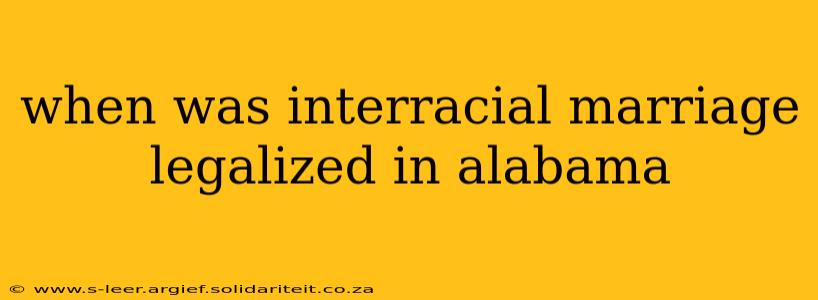The legalization of interracial marriage in Alabama has a complex history, marked by a long struggle against discriminatory laws and a significant legal victory. Understanding this history requires looking beyond a single date, as the full legal equality enjoyed today emerged gradually.
What is the exact date interracial marriage was legalized in Alabama?
While there isn't one single date marking the complete legalization of interracial marriage in Alabama, the landmark Supreme Court case Loving v. Virginia (1967) had a direct and decisive impact. This ruling invalidated laws prohibiting interracial marriage across the United States, including Alabama. Therefore, the effective date for the legalization of interracial marriage in Alabama is considered to be 1967, following the Loving v. Virginia decision. However, the fight for full acceptance and equality continued even after this landmark ruling.
Were there any challenges to the legalization of interracial marriage in Alabama after Loving v. Virginia?
Yes, even after the Loving v. Virginia decision, there were challenges and resistance to the legalization of interracial marriage in Alabama. While the state couldn't legally prohibit such marriages, discriminatory practices and social biases persisted for many years. Enforcement of the Loving v. Virginia decision and the dismantling of deeply ingrained prejudice took time and further legal battles.
How long did it take for interracial marriage to be fully accepted in Alabama?
Full acceptance of interracial marriage in Alabama, moving beyond legal recognition to widespread social acceptance, has been a gradual process spanning decades. While the law changed in 1967, deeply ingrained societal prejudices took much longer to overcome. Even today, some vestiges of prejudice may linger, though the vast majority of Alabamans accept interracial marriage as a legal and social norm.
What was the legal landscape in Alabama before Loving v. Virginia?
Before Loving v. Virginia, Alabama had laws explicitly prohibiting interracial marriage. These laws were rooted in racial segregation and the deeply entrenched system of Jim Crow laws, which aimed to maintain racial hierarchy and discrimination. These anti-miscegenation laws were discriminatory and a violation of fundamental human rights.
What were the implications of Loving v. Virginia for Alabama?
The Loving v. Virginia decision had profound implications for Alabama. It struck down laws that had been used to enforce racial segregation and inequality for generations. It represented a victory for civil rights and a significant step toward racial equality. The case paved the way for further legal challenges to discriminatory laws and practices in Alabama and across the nation.
What were the social reactions to the legalization of interracial marriage in Alabama?
The social reactions to the legalization of interracial marriage in Alabama were varied and complex. While the Supreme Court decision marked a legal victory, it did not immediately erase deeply ingrained prejudices and resistance. Some individuals and groups openly opposed the ruling, while others welcomed it as a step toward a more just and equitable society. The impact varied across different communities within Alabama, reflecting the diverse social and political landscape of the state. The period following the ruling witnessed a spectrum of responses, ranging from outright defiance to gradual acceptance.
This comprehensive overview details the history of interracial marriage legalization in Alabama, addressing the complexities and nuances beyond a simple date. The path to full legal and social acceptance was a long and challenging one, highlighting the ongoing struggle for racial equality and the importance of landmark legal decisions like Loving v. Virginia.
